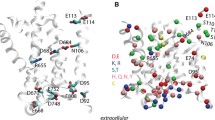Abstract
The problem of predicting the kinetics of proton efflux and the decay of the internal proton concentration for vesicles containing one or more buffers for which the internal proton concentration is initially higher than that of the surrounding medium is examined. An analytical solution is derived that describes the time course of the proton efflux from vesicles and the decay of the internal proton concentration under conditions of zero transmembrane electric potential. The effect of the internal buffers is to increase the time required for the proton concentration gradient to equilibrate across the membrane. To simplify the analysis we assume that the equilibration of the internal and external proton activity is due primarily to proton diffusion through the membrane, and not to hydroxyl ion flux. For a vesicle containing a single buffer the solution requires six independent physical parameters: the initial internal proton concentration, the external proton concentration, the ratio of the vesicle surface area to the internal volume, the permeability coefficient of the membrane for protons, the total concentration of the internal buffer, and the equilibrium constant for the dissociation of the internal buffer. Determination of these physical values is sufficient to predict the time dependence of the internal proton concentration and of the proton efflux. Over a pH range that is below or near the pK of the internal buffer the solution is complex. However, if the initial pH is one unit or more higher than the pK of the internal buffer the kinetics of the internal proton concentration and proton efflux can be described by a pseudo first order reaction. In this case the apparent rate constant depends linearly on the permeability coefficient and is dominated by the total internal buffer concentration and its pK. For example, increasing the internal buffer concentration inside a vesicle by 10-fold results in an approximately 10-fold increase in the half-time of the proton efflux kinetics. The theoretical analysis is applied to thylakiod vesicles using experimentally determined values for the physical parameters. The predictions of the analysis are compared to experimentally observed kinetics.
Similar content being viewed by others
References
Mitchell P (1976) Possible molecular mechanisms of the protonmotive function of cytochrome systems. J. Theor Biol 62: 327–367
Ort DR and Melandri BA (1982) In: Govindjee (ed.) Photosynthesis: Energy Conversion by Plants and Bacteria, Vol. I. Mechanism of ATP Synthesis. pp 537–587. New York: Academic Press
Westerhoff HV, Melandri BA, Ventoli G, Azzone GT and Kell DB (1984) A minimal hypothesis for membrane-linked free-energy transduction: The role of independent, small coupling units. Biochim Biophys Acta 768: 257–292
Ferguson SJ (1985) Fully delocalised chemiosmotic or localised proton flow pathways in energy coupling? A scrutingy of experimental evidence. Biochim Biophys Acta 811: 47–95
Whitmarsh J (1987) The effect of internal buffers on the proton—hydroxide decay kinetics in vesicles—an analytical solution. Manuscript in preparation.
Schönfeld M and Shickler H (1984) The permeability of the thylakoid membrane for protons. FEBS Lett 167: 231–234
Ho LK, Liu J, Saunders DR and Wang JH (1979) Light dependence of the decay of the proton gradient in broken chloroplasts. Biochim Biophys Acta 547: 149–160
Abbott MS and Dilley RA (1983) Light-dependence proton efflux from chloroplast thylakoids. Arch Biochem Biophys 222: 95–104
Izawa S (1970) The relation of post-illumination ATP formation capacity (X E) to H+ accumulation in chloroplasts. Biochim Biophys Acta 223: 165–173
Hangarter RP and Good NE (1984) Energized state responsible for adenosine 5-'triphosphate synthesis in preilluminated chloroplast lamellae. Biochem 23: 122–130
Izawa S and Hind G (1967) The kinetics of the pH rise in illuminated chloroplast suspension. Biochim Biophys Acta 143: 377–390
Schönfeld M and Kopeliovitch BS (1985) Kinetics of dark proton efflux in chloroplasts. FEBS Lett 193: 79–82
Hangarter R and Ort DR (1986) The relationship between light-induced increases in the H+ conductivity of thylakoid membranes and activity of the coupling factor. Eur J Biochem 158: 7–12
Wolken JJ and Schwertz FA (1953) Chlorophyll monolayers in chloroplasts. J Gen Physiol 37: 111–120
Gregory P and Bradbeer JW (1973) Plastid development in primary leaves of Phaseolus vulgaris: The light-induced development of the chloroplast cytochromes. Planta 109: 317–326
Gaensslen R and McCarty RE (1971) Amine uptake in chloroplasts. Arch Biochem Biophys 147: 55–65
Flores SC, Graan T and Ort DR (1983) Measurement of the permeability of the chloroplast thylakoid membrane to amine buffers. Photobiochem 6: 293–304
Walz D, Goldstein L and Avron M (1974) Determination and analysis of the buffer capacity of isolated chloroplasts in the light and in the dark. Eur J Biochem 47: 403–407
Junge W, Ausländer W, McGeer AJ and Runge T (1979) The buffering capacity of the internal phase of thylakoids and the magnitude of the pH changes inside under flashing light. Biochim Biophys Acta 546: 121–141
Wille B and Lavergne J (1982) Measurement of proton translocation in thylakoids under flashing light using a spin-labelled amine. Photobiochem. Photobiophys 4: 131–144
Ort DR, Dilley RA and Good NE (1976) Photophosphorylation as a function of illumination time II. Effects of permeant buffers. Biochim Biophys Acta 449: 108–124
Hangarter R and Ort DR (1985) Cooperation among electron-transfer complexes in ATP synthesis in chloroplasts. Eur J Biochem 149: 503–510.
Author information
Authors and Affiliations
Rights and permissions
About this article
Cite this article
Whitmarsh, J. Proton decay kinetics for vesicles containing buffers—an analytical solution. Photosynth Res 12, 43–62 (1987). https://doi.org/10.1007/BF00019150
Received:
Accepted:
Issue Date:
DOI: https://doi.org/10.1007/BF00019150




